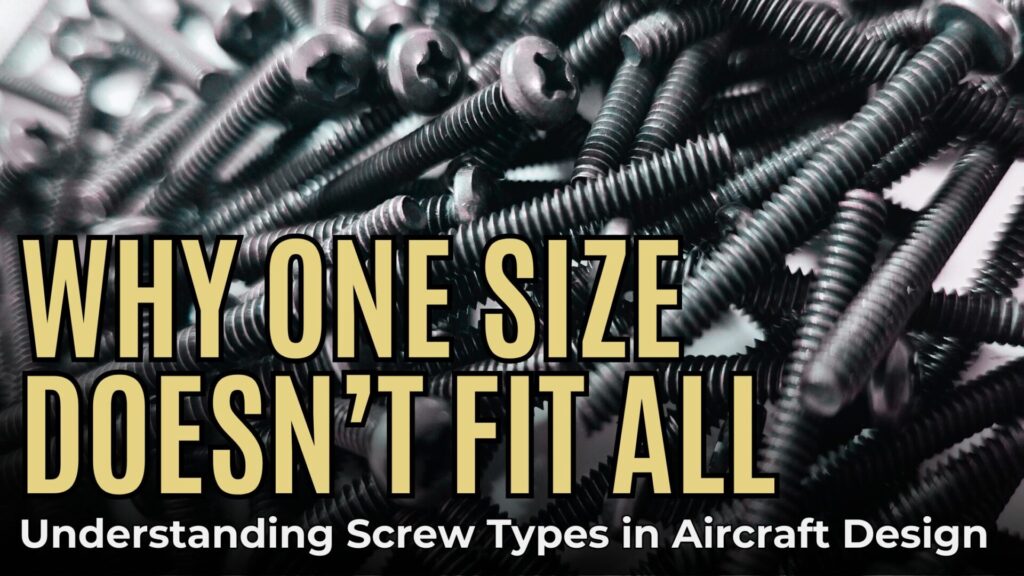Your cart is currently empty!
Understanding Screw Types in Aircraft Design

When most people think about aviation, their minds jump to roaring engines, sleek fuselages, or the intricate dance of flight controls. But behind all that glamour are the unsung heroes holding everything together — screws. And in the aerospace world, if you understand screw types, not just any screw will do, and one size does not fit them all.
Understanding Screw Types
A screw in your kitchen drawer, designed to hold wood or drywall vs A screw in an aircraft? What makes them different? The difference is the fact that one is engineered to withstand extreme temperatures, constant vibration, pressure differentials, and corrosive environments, and the other is designed for a completely different thing.
It’s a whole different ballgame.
Aviation screws are high-precision fasteners, often designed and certified to military (MS), aerospace (NAS), or AN (Army-Navy) standards. They have one job: keep components secured under extreme conditions without failing. And depending on where they're used — inside the cockpit or deep in the wing structure — different screws are required.
Screw Types in Aircraft Design
Let’s break it down. Here are the key types of aviation screws and where you’ll typically find them:
1. Structural Screws
These are designed to handle loads — shear, tensile, and sometimes torque. You'll find them:
- In wing-to-body connections
- Around load-bearing fuselage components
- Securing engine cowlings or landing gear fairings
Common types: NAS144, NAS514, and other NAS-series fasteners
Materials: Titanium or high-strength alloy steel
Fun fact: They’re often paired with lock nuts or used in interference fits to prevent movement.
2. Non-Structural Screws
These don’t carry structural loads but still play an important role. They're used for:
- Attaching interior panels
- Securing avionics trays
- Mounting access doors or fairings
Common types: MS24693C, AN526, NAS1097
Head styles: Pan, truss, or countersunk depending on application
Bonus: Many are cadmium-plated to resist corrosion.
3. Hi-Lok and Torque-Set Fasteners
These are kind of like the super screws of aviation. They're precision-torqued fasteners used when space is tight but performance matters.
- Used in primary structures and high-load zones
- Designed for single-sided installation, ideal for wings or tails where access is limited
4. Self-Tapping and Sheet Metal Screws
For quick installation into thin materials (usually aluminum):
- Common in interior installations, bracket attachments
- Often used temporarily during manufacturing or MRO (maintenance, repair, and overhaul)
Heads: Oval, flat, or pan
Drive types: Phillips, Torq-set, Tri-Wing (to prevent tampering or stripping)
The Importance of Head Styles and Drive Types
Let’s talk top hats — screw head styles, that is.
| Head Type | Use Case |
|---|---|
| Pan Head | General attachment, interior panels |
| Truss Head | Wide surface area, good for soft materials |
| Countersunk | Flush with surface, aerodynamic surfaces |
| Hex Head | High torque applications, structural |
You’ll also see drive styles like:
- Phillips: Common, but prone to cam-out
- Torq-set: Used in high-vibration areas
- Tri-Wing: Common in tamper-resistant locations
Why Precision Matters
The wrong screw in the wrong place can literally be catastrophic. Using a general-purpose screw where a torque-rated NAS fastener is required can lead to:
- Fatigue cracks
- Loosening due to vibration
- Compromised structural integrity
That’s why aircraft hardware isn’t just sold in bins at your local hardware store. Each screw is traceable, tested, and spec’d out according to its exact application.
Final Thoughts
In aviation, “close enough” doesn’t fly. Engineers, mechanics, and suppliers all play a role in ensuring the right screw is used in the right place — every time. Whether it’s anchoring a wing or securing a cabin panel, each fastener is selected with performance, weight, durability, and safety in mind.
So the next time you’re walking down the aisle of a commercial jet, remember: the safety of your flight depends, in part, on a whole lot of very specific, very serious screws.
Posted:
by:
Tags:

Leave a Reply
You must be logged in to post a comment.